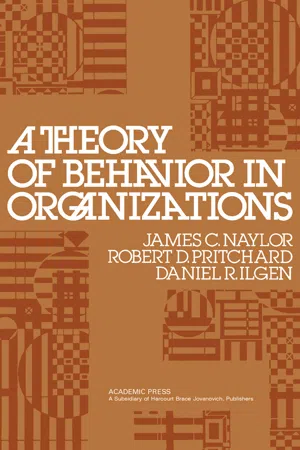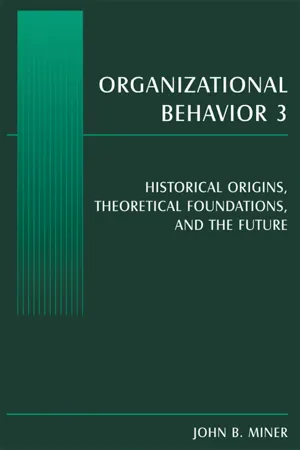Business
The Theory Of Individual Behavior
The Theory of Individual Behavior in business refers to the study of how individuals make decisions and behave within an organizational setting. It encompasses various psychological, sociological, and economic theories to understand and predict individual actions in the workplace. This theory is crucial for businesses to comprehend and manage employee behavior, motivation, and performance.
Written by Perlego with AI-assistance
Related key terms
1 of 5
3 Key excerpts on "The Theory Of Individual Behavior"
- eBook - PDF
- James C. Naylor, Robert D. Pritchard, Daniel R. Ilgen(Authors)
- 2013(Publication Date)
- Academic Press(Publisher)
In fact, we are not sure what such a term means, except that the primary unit of interest, or focus, is not the individual but is instead some macro entity. In fact, we are some-what uncomfortable with the notion that we have a theory of organiza-tional behavior—a term that Karl Weick once referred to as being utter nonsense. A second point worth remembering is that whereas the theory was developed with the intent of creating a theory of individual behavior in organizations, it soon became clear that such a theory inevitably becomes a general theory of behavior. That is, work behavior is not idiosyncratic; it does not require a theory that would apply only to that specific context or environment. I f a theory is capable of dealing with individual behavior in an organization, it should be as capable of dealing with individual behav-ior outside the organization. What is unique about the environment in any type of organization that would call for a special theory of behavior peculiar only to that setting? Therefore, the theory presented here is proposed as a general theory of behavior applicable to the behavior of an individual in any context, within or outside the work environment, al-though admittedly our contextual emphasis will be that of the work setting. T h e theory presented in the following pages is a cognitive theory of behavior. It assumes that man is rational (or at least nonrandom) for the most part, and that as a systematic or nonrandom generator of behavior, man's actions are explained best in terms of conscious, thinking acts on the part of the individual. Furthermore, the theory is founded upon the concept that the basic conscious action of the individual is the action of 1. A Viewpoint Concerning Organizational Behavior 3 choice, or the process of choosing among alternatives. - eBook - ePub
Organizational Behavior 3
Historical Origins, Theoretical Foundations, and the Future
- John B. Miner(Author)
- 2006(Publication Date)
- Routledge(Publisher)
ORGANIZATIONAL BEHAVIOR 3 PART I THEORY, RESEARCH, AND KNOWLEDGE OF ORGANIZATIONAL BEHAVIORWhat is organizational behavior? It is a social science discipline—much like cultural anthropology, economics, political science, psychology, and sociology. This means that it utilizes the scientific method to establish truth and to validate its theories. It is a discipline that historically has had its intellectual home in business schools. It is a new discipline relative to the other social sciences, having its origins in the mid-twentieth century. The key points are that it is a science and that it has a history, which, though short, has been quite turbulent.Although the exact boundaries of the discipline are somewhat fuzzy (see Blood 1994), organizational behavior’s focus is clearly on the world of organizations. The concern is first with the behavior and nature of people within organizations, and second with the behavior and nature of organizations within their environments. The term organizational behavior initially referred only to the behavior and nature of people in organizations. Given the fuzziness of its boundaries, the discipline always had a tendency to stretch beyond that domain, however. By the time it approached twenty-five years of age it clearly had staked a claim to incorporating the behavior and nature of organizations as well (see Miles 1980). This is historically consistent in that both the study of the behavior and nature of people and the study of the behavior and nature of organizations emerged in the business schools in the same places at the same times.In line with its professional school origins, organizational behavior is an applied discipline, concerned with matters of practice and application. Despite this orientation, it currently has relatively few members who actually devote their primary professional efforts to the practice of organizational behavior in business and other organizational settings; rather, most are concentrated in academia—teaching, writing, and conducting research. In my opinion this is unfortunate; the field would be better off not by reducing its academic efforts, but by expanding its practitioner efforts. We will return to this theme in various ways throughout this book. - eBook - PDF
- Ricky Griffin(Author)
- 2021(Publication Date)
- Cengage Learning EMEA(Publisher)
385 Learning Outcomes After studying this chapter, you should be able to: 14-1 Explain the nature of the individual–organization relationship. 14-2 Describe how personality and personality attributes affect behavior in organizations. 14-3 Discuss individual attitudes in organizations and how they affect behavior. 14-4 Describe basic perceptual processes and the role of attributions in organizations. 14-5 Discuss the causes and consequences of stress and how it can be managed. 14-6 Describe creativity and its role in organizations. 14-7 Explain how workplace behaviors can directly or indirectly influence organizational effectiveness. T he people who populate today’s business world are characterized by a wide variety of personalities, behaviors, and attitudes. While most people in business have relatively healthy and constructive personalities and behave in ethical and productive ways, there are some who reflect different profiles. Indeed, myriad different and unique characteristics reside in each and every employee and manager. These affect how they feel about the organization, how they will alter their future attitudes about the firm, and how they perform their jobs. These characteristics reflect the basic elements of individual behavior in organizations. This chapter describes several of these basic elements and is the first of five chapters designed to develop a more complete perspective on the leading function of management. In the first section we investigate the basic relationships that exist between individuals and organizations. The following section introduces the concept of personality and discusses several important personality attributes that can influence behavior in organizations. We then examine individual attitudes and their role in organizations. The role of stress in the workplace is then discussed, followed by a discussion of individual creativity.
Index pages curate the most relevant extracts from our library of academic textbooks. They’ve been created using an in-house natural language model (NLM), each adding context and meaning to key research topics.


